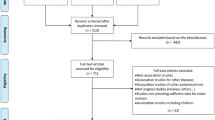Abstract
Conflicting data suggest an association between leptin gene polymorphisms and essential hypertension independently of obesity. The aim of this study was to evaluate, in severely obese subjects, the role of one of these polymorphic markers in relation to the development of hypertension. The study included 325 obese patients with mean body mass index (BMI) of 46±6.94 kg/m2. One hundred sixty-six were hypertensive and 159 normotensive. In both groups, the presence of a tetranucleotide repeat in the 3′ flanking region of the Ob gene was investigated using polymerase chain reaction (PCR). Due to the genetic variant, in the region studied it is possible to distinguish two alleles with different size distribution: Class I (shorter one) and Class II (longer one). Class I and Class II allele frequencies were not significantly different in obese patients when analyzed according to the presence or absence of hypertension. The results presented herein do not support a significant association of this Ob gene polymorphism with hypertension. These findings are in contrast with that reported in other populations. However, we cannot rule out that different ethnicity and/or phenotypic variability might mask small effects.
Similar content being viewed by others
References
Kaufman JS, Durazo-Arvirn RA, Rotimi CN, McGee DL, Cooper RS, for Investigation of the International Collaborative Study on Hyoertension in Blacks. Obesity and hypertension prevalence in populations of African origins. Epidemiology 1999, 7: 398–405.
Stamler R, Stamler J, Riedlinger WF, Algera G, Roberts RH. Weight and blood pressure: findings in hypertension screening of 1 million Americans. JAMA 1978, 240: 1607–10.
Kannel WB, Brand N, Skinner JJ Jr, Dawbwr TR, McNamara PM. The relation of adiposity to blood pressure and development of hypertension. Ann Intern Med 1967, 67: 48–59.
Hsueh WA, Buchanan TA. Obesity and hypertension. Endocrinol Metabol Clin North Am 1994, 23: 405–27.
Reaven GM, Lithell H, Landberg L. Hypertension and associated metabolic abnormalities: the role of insulin resistance and the sympathoadrenal system. N Engl J Med 1996, 334: 374–81.
Zhang Y, Proenca R, Maffei M, Barone M, Leopold L, Friedman JM. Positional cloning of the mouse obese gene and its human homologue. Nature 1994, 372: 425–32.
Stephens TW, Basinski M, Bristow PK, et al. The role of neuropeptide Y in the antiobesity action of the obese gene product. Nature 1995, 377: 530–2.
Masuzaki H, Ogawa Y, Isse N, et al. Human obese gene expression: Adipocyte-specific expression and regional differences in the adipose tissue. Diabetes 1995, 44: 855–8.
Dunbar JC, Hu Y, Lu H. Intracerebroventricular leptin increases lumbar and renal sympathetic nerve activity and blood pressure in normal rats. Diabetes 1997, 46: 2040–3.
Shek EW, Brands MW, Hall JE. Chronic leptin infusion increases arterial pressure. Hypertension 1998, 31: 409–14.
Aizawa-abe M, Ogawa Y, Masuzaki H, Ebihara K, Nakano K. Pathophysiological role of leptin in obesity-related hypertension. J Clin Invest 2000, 105: 1243–52.
Shintani M, Ikegami H, Yamato E, et al. A novel microsatel-lite polymorphism in the human OB gene: a highly polymorphic marker for linkage analysis. Diabetologia 1996, 39: 1398–1401.
Shintani M, Ikegami H, Fujisawa T, et al. Leptin gene polymorphism is associated with hypertension indipendent of obesity. J Clin Endocrinol Metab 2002, 87: 2909–12.
Onions K.L, Hunt SC, Rutkowski MP, et al. Genetic markers of the leptin (ob) locus are not significantly linked to hypertension in Africa Americans. Hypertension 1998, 31: 1230–4.
Wadden TA, Bartket S, Letizia KA, Foster GD, Stunkard AJ. Relationship of dieting history to resting metabolic rate, body composition, eating behaviour, and subsequent weight loss. Am J Clin Nutr 1992, 56: 203S-8S.
Haffner SM, Miettinene H, Stern MP. The homeostasis model in the S. Antonio Heart Study. Diabetes Care 1997, 20: 1087–92.
Van Itallie TB. Health implications of overweight and obesity in the United States. Am Intern Med 1985, 103: 983–8.
Ioannidis JP, Trikalinos TA, Ntzani EE, Contopoulos-Ioannidis DG. Genetic association in large versus small studies: an empirical assessment. Lancet 2003, 361: 567–71.
Author information
Authors and Affiliations
Corresponding author
Rights and permissions
About this article
Cite this article
Maestrini, S., Mencarelli, M., Verti, B. et al. Lack of association between the tetranucleotide repeat polymorphism in the 3′-flanking region of the leptin gene and hypertension in severly obese patients. J Endocrinol Invest 29, 776–780 (2006). https://doi.org/10.1007/BF03347370
Accepted:
Published:
Issue Date:
DOI: https://doi.org/10.1007/BF03347370




